
There is a valuable resource available for anyone interested in the interchange between Arabic texts and the Latin-writing world. This can be found at http://www.arabic-latin-glossary.philosophie.uni-wuerzburg.de/?nav=r&page=1

There is a valuable resource available for anyone interested in the interchange between Arabic texts and the Latin-writing world. This can be found at http://www.arabic-latin-glossary.philosophie.uni-wuerzburg.de/?nav=r&page=1

[In 1953 Gregor von Rezzori published a fictional satire of an anonymous East European/Near Eastern land he called Maghrebinia. Here is an excerpt that is still poignant today…]
“I am about to report on the great and glorious country Maghrebinia. You won’t find it on a map, it isn’t in any atlas or on any globe. There are people who say it lies in southeast Europe, others like to think it is southeast Europe, but, for heaven’s sake, what is southeast Europe? … Of course pedantic people might make an effort to define the borders of Maghrebinia geographically and vaguely, but just these pedants would get it all wrong. For Maghrebinia’s true borders lie in the hearts and souls of its people, and pedants don’t know the first thing about the hearts and souls of people…â€
“Maghrebinia is beautiful. Continue reading Tabsir Redux: An Unprofitable Prophet from Maghrebinia
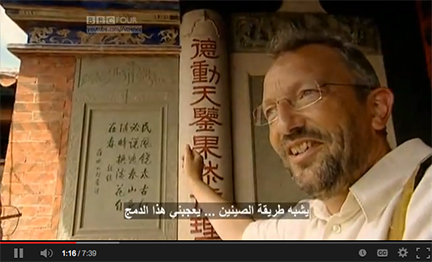
Mackintosh-Smith in China
One of the most celebrated Arab travelers was the 14th century Ibn Battuta. For a book on the travels of Ibn Battuta, Timothy Mackintosh-Smith literally followed in the footsteps that the Arab savant had taken some seven centuries earlier. In addition to the book, a documentary film was made. An excerpt of the film on Tim’s experience int he Chinese city of Zaytun is available on Youtube and well worth watching. Other Youtube excerpts are on an Ibn Battuta shopping mall in Dubai and on Turkey. Vimeo provides access to the entire first part of the three-part series. For more information on the work of Mackintosh-Smith, check out his website. An earlier documentary on the English Sheikh and the Arab Gentleman by Bader Ben Hirsi is available in its entirely on Youtube.
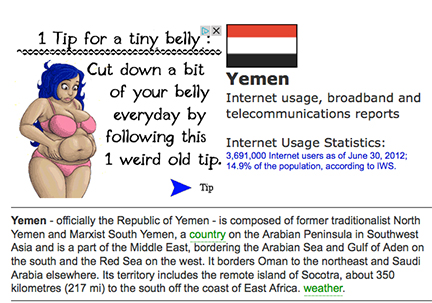
The juxtaposition of information and advertising on Internet sites always amazes me. In researching Internet use in Yemen for a paper to be delivered at the annual American Anthropological Association meeting in Chicago in November, I came across the image above. I suppose if any belly dancers accessed the page, this ad might be of value. Indeed, it must be a weird tip…
Poem by George El-Hage
كنّا ابتدأنا
عادتْ لنا الرؤيا وأبكانا اللقاءْ
Ø·Ùلان لا يشÙيهما غير البكاءْ
عادت لنا الأيام٠مزهرةً
ما همّنا الØسّاد٠إنْ Øسدوا.. سواء
Ùأبكي.. ولا تخشَي.. على كتÙÙŠ
أشتاق٠أن تبكي على كتÙÙŠ سماء
ما أروعَ اللØظات٠تجمعنا
طيران عن أشواقنا ضاق الÙضاء
هذي يدي ذوبي براØتها
عطراً ولوناً بعض بهجته الضياء
وتساقطي سØباً على عطشي
السي٠تواقٌ إلى لون الدماء
يا ديمتي يا الآه من وتري
يا البالَ مرسوما بأنÙاس الصÙاء
إني لأشعر إذ أضاجعكÙ
أني أضاجع كل أجناس النساء
أشياؤك الكانت تراودني
ظلّت وعوداً دونها غصص اشتهاء
Continue reading كنّا ابتدأنا
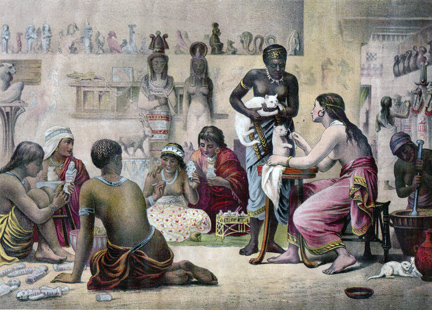
My grandmother’s aunt, Ms. Ida Hoyt, put together several scrapbooks in the 1890s. The pages are quite frayed today, but most of the images are still in good shape. Here we see an artist’s reconstruction of cat love in ancient Egypt at a time when the archaeology of Egypt was still in its infancy stage.
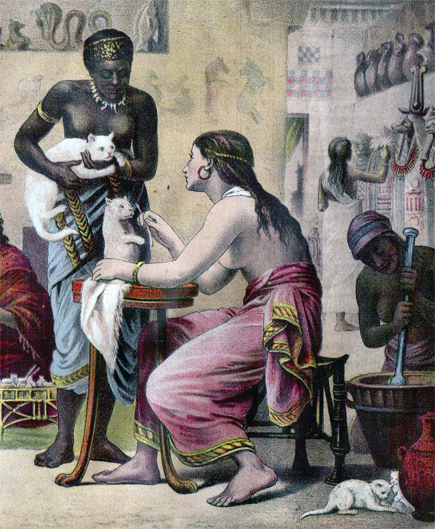
Detail
For Part 1, click here; for Part 2, click here.

Celebrating Saudi Arabia’s National Day
In case you missed it, September 23 was Saudi Arabia’s National Day, the oil-driven nation’s 4th of July. Not surprisingly many people, proud of their country, took to the streets to celebrate. But what is good for the state is not necessarily seen as good for the faith, especially in the conservative Wahhabi/Salafi variety that weds tribal origin with a dogmatic theology. The tension between a strict form of Islamic practice and the diversity that instills cultural practices has always been a problem, perhaps even more so with the wealth economy that the current generation of Saudi youth has grown up in. In 1927 King Abdul Aziz established the Committee for Promotion of Virtue and The Prevention of Vice. In short this is known as the “religious police.” For those less familiar with Islamic doctrine, this relates back to the classic Quranic principle of al-amr bi- al-maÊ¿ruf wa-al-nahy Ê¿an al-munkar, generally translated as commanding right and and forbidding wrong. There is a long history about the use of this penchant phrase, analyzed in detail by Michael Cook in his Commanding Right and Forbidding Wrong in Islamic Thought (Cambridge University Press, 2010), a work of over 700 pages.
Abdullah Hamidaddin has written an interesting commentary on a recent tragedy on the Saudi National Day in which a car of religious police chased a vehicle that apparently was thought to contain two drunken men. In the chase the car careened off the road, killing the driver and his brother. The religious police fled the scene, but the chase was captured on a cell phone video. When the video was posted to social media, there was an outcry to rein in the zealous religious police. In this case it turned out the men had not been drinking.
What were these “thought police” thinking? I say “thought” rather than “religious” police, because the very nature of the committee leads to a kind of witchcraft mentality. Continue reading Thought Police: What were they thinking?

My grandmother’s aunt, Ms. Ida Hoyt, put together several scrapbooks in the 1890s. The pages are quite frayed today, but most of the images are still in good shape. The story behind this image shows the antipathy towards the “Turks” at the time.
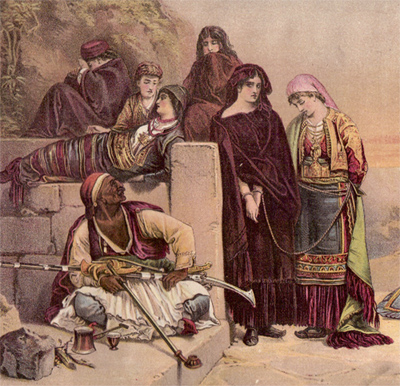
Detail of the young maidens
For Part 1, click here.